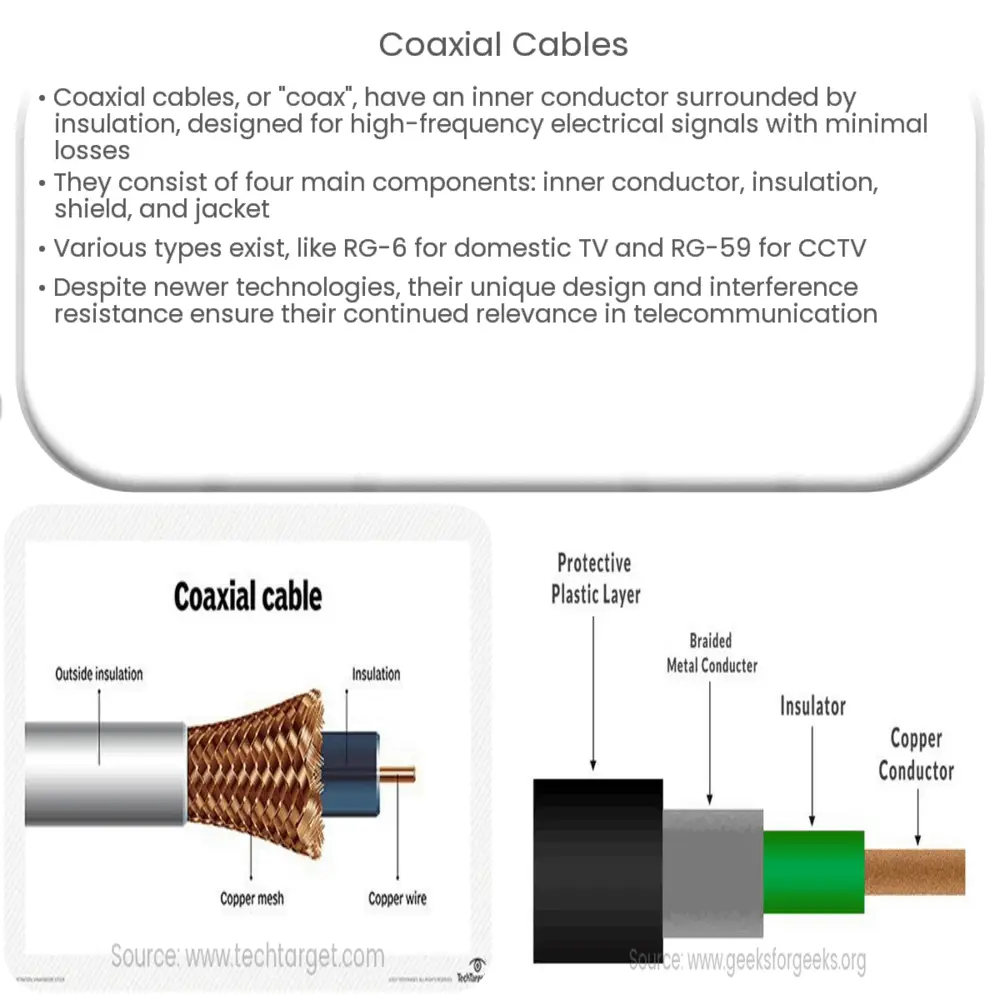Explore the structure, types, applications, pros, and cons of coaxial cables, and their relevance in future technologies.

Understanding Coaxial Cables
Coaxial cables, often referred to as coax, are a type of electrical cable that has an inner conductor surrounded by a tubular insulating layer, wrapped in a tubular conducting shield. Its invention can be traced back to the early 20th century, and it was designed to carry high-frequency electrical signals with low losses. This design helps protect the signal being carried from external electromagnetic interference, making coaxial cables a favored choice for a wide range of applications.
Structure of Coaxial Cables
The fundamental design of coaxial cables consists of four main components. These are as follows:
- The Inner Conductor: This is the core, composed of solid or stranded wire, which carries the actual signal.
- The Insulation: Surrounding the inner conductor, it serves as a barrier to prevent electrical signals from leaking out.
- The Shield: This is the outer conductor, which both prevents external interference from getting in and keeps the signal contained within the cable.
- The Jacket: This is the outermost layer, providing physical protection for the cable.
Types of Coaxial Cables
There are several different types of coaxial cables, which differ in their construction materials and dimensions. Here are a few common ones:
- Hard Line Coaxial Cable: These cables are used for high-power radio frequency (RF) connections, such as those in television and radio broadcasting.
- RG-6 Coaxial Cable: This type is commonly used for domestic television systems. RG-6 cables are designed to carry signals in the range of 1 to 1000 MHz.
- RG-59 Coaxial Cable: Previously used for television systems before RG-6, this cable is now primarily used in closed-circuit television (CCTV) and video surveillance systems.
Applications of Coaxial Cables
Coaxial cables have a broad spectrum of applications. They are commonly used in:
- Television and Radio Frequency Applications
- Internet Connections
- Computer Networks
Advantages and Disadvantages of Coaxial Cables
Like any technology, coaxial cables come with their own set of advantages and disadvantages. Let’s discuss a few of these:
Advantages:
- Less Susceptible to Interference: Thanks to their shielding, they are less prone to signal interference from external sources compared to other cable types.
- Higher Bandwidth: Coaxial cables can carry a greater amount of data compared to other cables, making them suitable for applications demanding high data rates.
- Longer Distances: They can carry signals over longer distances with less loss, making them a good choice for rural or expansive installations.
Disadvantages:
- Cost: Coaxial cables can be more expensive than other types of network cables, such as twisted pair or fiber optic cables.
- Flexibility: These cables are generally stiffer than other types, making them harder to install in tight spaces or around sharp corners.
- Size: Due to their construction, coaxial cables can be bulkier than other types of cables.
Future of Coaxial Cables
Despite the advent of newer technologies like fiber optics, coaxial cables continue to find relevance in modern applications. Developments such as DOCSIS 3.1 technology are allowing coaxial cables to carry much higher bandwidth, rivaling fiber optic cables. This, in conjunction with their robustness against interference, ensures that coaxial cables will continue to be a key player in the field of telecommunication and networking.
Conclusion
In conclusion, coaxial cables have stood the test of time, thanks to their unique design and high performance in carrying signals over large distances. Despite certain drawbacks such as cost and flexibility, they remain a popular choice for many applications, including TV broadcasting, internet connections, and computer networks. As technology continues to evolve, so does the design and utility of these cables, promising a bright future for their continued use.

